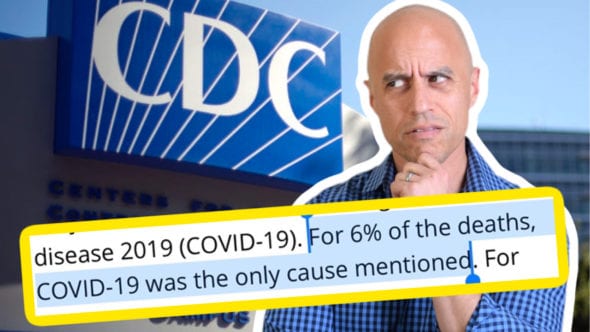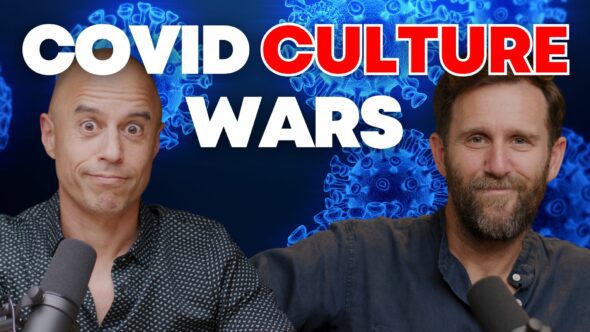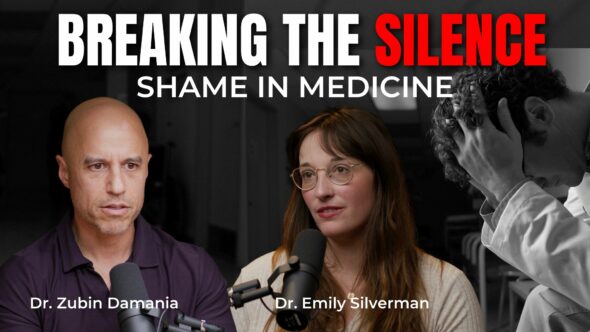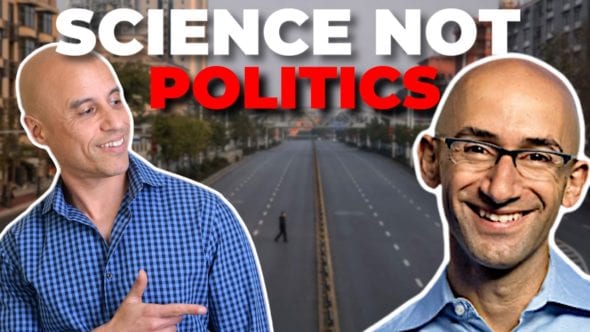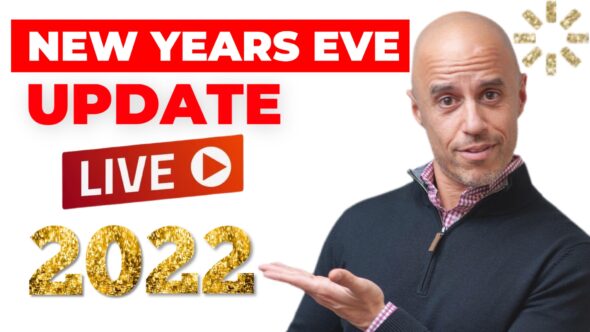What’s up with the side effects from the second COVID vaccine dose? And should you get antibody testing to prove you’re immune?
Here’s a piece on the lack of utility of antibody testing, and here’s one on second shot side effects.
Here’s that preprint on antibody responses to the vaccine in patients who’ve previously been exposed to coronavirus.
Full Transcript Below!
– So that second coronavirus shot, it is a doozy. And I’ll tell you, I say that from personal experience. I was knocked on my a** by that thing. So the first shot I got, Moderna, blew it off, a little sore arm, no big deal, right? The second shot, a month later eight hours after the shots happened I was having fevers, shaking, chills muscle aches felt like I got hit by a train. Throbbing headache, couldn’t sleep. The arm was like red and swollen. I was just behaving like a complete diva, like, you know, telling Mrs. Dogg, oh, woe is me.
The kids are putting electric blankets on me. So it sounds really appealing, right? You guys are like, sign me up, okay? Well, look for those people who’ve been lucky enough to get both vaccinations so far of the mRNA vaccines, you kind of know this weird feeling that even though you’ve gone through this, it means something. It means that your immune system is working. So what I want to talk about is why we have those effects and what it means. And also whether getting tested for antibodies afterwards to see if you’re really immune makes any sense at all. Spoiler alert, it doesn’t.
All right. So the way that this thing goes down is like this. And you remember the Moderna shot has a little more volume in it. It’s a little higher dosage than the Pfizer, which may explain why in the trials, people tended to have a little more side effects with Moderna, right? And again, in the end it doesn’t really make a big difference but this is how it works. The first time you get that injection, assuming you’ve never had COVID, which we’ll talk about in this show your immune system is seeing what’s being injected in the arm.
And what’s being injected are these lipid nanoparticles that encase messenger RNA. Now, both of those things are foreign to the human body in the sense that they’ve been manufactured. In other words, the human body isn’t making that exact type of messenger RNA, and it isn’t making that lipid nanoparticle. So it looks foreign to a part of the immune system that’s kind of the, the sort of Jack-of-all-trades, when something comes that’s new, it just activates. And that’s the innate immune system. And the way it responds is it sees something foreign and it just goes, okay, fire the torpedoes, right? Everything. And though that response is things like int
erferons, cytokines, local inflammation, all the kinds of things you might see after that injection. Some redness, some soreness, and a general sense of like, yeah, something’s not quite right. And that in itself can be enough for some people to trigger the symptoms of headaches, muscle aches, sometimes fevers and chills, even if you’ve never been exposed to this before, but for most people, it doesn’t. Now come back a month later. And what happens is because that messenger RNA has gotten into the cells and it’s been converted into spike protein.
And then now the immune system has seen this spike protein and it’s learned, so B-cells, T-cells have recognized it and said, okay, next time this happens. We are going apes**t on this. And that’s happens with the second dose. So first dose you get that innate immune system kind of fires up. Eh, maybe you have some side effects. Second dose, innate immune system fires up again. Oh, this is back. Let’s do the thing we did before. But now you have a clone army of B-cells and T-cells that are actually sitting there waiting. They’re like, okay, we’ve been activated from the last thing, we’ve learned what this thing is.
If we see it again, we’re gonna jump on it right away. And they do. So that second shot then reprimes the immune system. Those B-cells immediately start producing antibody. And what happened to me is eight hours after the shot, I started feeling the effects that I never felt from the first shot. And that’s a sign that first of all, this thing is working. Second of all, it really boosts and reprimes the immune system so that now the presumption is you’re gonna get a very powerful and very long lasting, hopefully, immune response the next time you see the real coronavirus, right? Even with the variants, because even with mutations in the spike protein, there are so many sites on that protein to which you’ve generated antibodies.
It’s a polyclonal response that most likely you’re gonna end up not, at least having some efficacy against even the nastiest variants so far, like the South African variant. And so that second time when you get all those effects, if you frame it mentally as, oh, this thing is kicking in. It’s working, my immune system is doing its thing. That is a vastly better framing than, oh my God, I’ve been poisoned with some kind of toxin that’s gonna kill me, because it sure feels like that. Now the nice thing is usually 24, 48 hours later, in fact, almost always people are like right as rain. Like I, when that time period hit suddenly I was like a 100% percent back to what I was before because remember, there’s no replicating virus driving the symptoms.
You don’t get the cough and the upper respiratory stuff that keeps driving cytokines and antibodies. So it’s this kind of one-time priming, right? Now, that brings us to the question of, and by the way I know a lot of people are nervous about getting the vaccine purely because of the side effects that they might experience, right? These symptoms that I was talking about. And some people are even saying, well, I’ll just get one then, and I won’t get the second. Which I think is a really bad idea because it’s that second, that in the trials generated, the immunogenicity that we see is potentially stronger than natural infection.
So it’s very hard to get people to come back for the second injection, for any injection that’s a two part injection, like HPV or these kinds of things, it’s very, Shingrix, it’s hard to get people to come back as it is, about a quarter of people don’t show up. So we really ought to be telling people like, you know, this is probably something you should do. Now there are some exceptions which we’re gonna talk about. And maybe that, that needs to change a policy. But this idea that you’re gonna always get the side effects is wrong.
‘Cause some people get them not at all for both vaccinations. Some people get them all on the first vaccine and the second one’s not a big deal. And then it depends on which vaccine you get. Some people are more reactogenic to Pfizer, so it’s a little bit of rolling the dice. My wife got the Pfizer only had a headache for the first injection, second injection sore arm, right? Now, one of the things to remember that a lot of people then go well, should I, after my injections because I didn’t have any side effects maybe I want to make sure it worked. I’m gonna go get one of these coronavirus antibody tests that are advertising all over the place.
It’s a blood test and it tests your blood to see if there are antibodies to specific aspects of the coronavirus. Is it a good idea? The answer is almost never. Almost never. And I’ll tell you why. First of all, it depends on what antibody they’re testing. So if they test a nucleocapsid antibody on the virus and you’ve gotten vaccinated, well, you’re not vaccinated against the nucleocapsid. You’re vaccinated against the spike protein. So it’s going to be negative and you’re not gonna know anything better. If it, if it actually tests the IgG for spike protein and you were vaccinated, there’s a chance that you don’t develop high enough levels of the spike protein antibodies to actually trigger the test to be positive, but nobody has correlated test positivity to actual immunity. So it means nothing.
The likelihood that you’re immune from the vaccine is very, very high, 95% in the trials, because it’s not just antibodies, there’s memory T cells. There’s other aspects of the immune system that are activated. And that remain active when you see the actual virus. And so testing your antibody levels, I’ve had a ton of people messaged me, oh, well, I got the vaccine but then I tested my antibodies and they were negative. And it’s like, well, we don’t know what that means. So don’t do it. There’s no point. You’re just wasting money and wasting a blood draw.
And the other issue is because we don’t have that correlation of what the antibody means to actual immunity, it’s not even an immunity passport that they’re talking about to have positive antibodies. All the antibodies can tell you is could it be that you were exposed to the virus in the wild. At some point, did you have a brush with this virus, either an asymptomatic infection or a very low inoculum or something that triggered just enough antibody that you’re able to detect it. And that can be useful just in terms of epidemiology. So if you’re part of a study to see how many people have actually been exposed, versus how many people have been tested with PCR, then it’s useful, but otherwise not much use. But there may be another use for it that might come in the future. And it’s this. And we don’t know yet. So this is still presumption.
There’ve been a couple of preprints that have come out. So they haven’t been peer reviewed, but they’re in Medrxiv and they basically say this, look, if you actually test people for antibodies prior to giving them the vaccine and then you study what happens, it turns out that in this small series, about 109 people say. If they tested negative for having any exposure to coronavirus before through these antibodies, and they got the first dose of the vaccine they had a certain amount of antibody response, and a certain amount of symptoms. If they tested positive for antibodies, meaning, hey, at some point they might’ve been exposed. They didn’t even know it. And they get the first dose of the vaccine. They had a massive antibody response.
Like 10 to 20 times what the person who was never, who had negative antibodies to begin with had. And that is again, an example of immune priming. They were primed by natural infection. Got the booster with the first shot and had this big response, likely with more symptoms too, right, from that first shot. And this 10 to 20 fold, higher response in antibodies. And that’s good. That’s again, a good sign. Now the question becomes should they then get the second shot? When we’re limited in the number of shots we can give, and I had Dr. Marty Makary on the show talking about this. And he advocated that we, you know we stick to one dose or no doses for people who have been exposed before, and he paints a case for this.
Paul Offit paints a case for maybe doing the opposite, but they’re both, they both make valid points. If you then give, if you then you look at that second dose in people who were never antibody positive. They attain levels that are still below what the booster gave the people who had been exposed to the virus initially. So in other words, you’ve been exposed to virus. You get the first mRNA vaccine. Your antibodies are sky high. They may even be higher. And this is pre-print stuff. They may even be higher than a naive person who never seen virus who gets both shots. So the question then becomes maybe we ought to do some antibody testing to see, do you need both? Because then we could save some vaccine. The problem is you got to do a blood test.
You got to wait for it to come back. You got to hope it’s not false positive because if it’s false positive, which happens with antibody testing, happens with any testing, then you’re gonna miss out giving that person the second dose and generating durable immunity. And we don’t yet have a good commercial measurement for how to test for whether you have durable immunity. You see that the problem here? So the simplest thing to do, do in the absence of more understanding and knowledge about it you still keep sciencing the crap out of it.
Simplest thing to do is do the two dose regimen as it was studied in as many people as possible. You might argue that people who have known coronavirus infection in the past might wait to get the vaccine, because that probably makes sense, and go from there. And then keep studying it and see well, maybe there’s a cheap and quick antibody test that can help eliminate the need for a second vaccine, that can then alleviate the stress on the system right now. But you know, we’re getting a third and probably a fourth vaccine that’s gonna be approved soon, supplies will go up.
The demand has been intense because people are educating themselves and realizing, oh, these things are actually seem to be safe, seem to be working. We’re learning more and more every day about how they’re safe and working. And I think it’s, the end of the pandemic here. It’s in sight. It’s so exciting. All this garbage we’ve been hearing of lock downs and schools and months of this horror, it’s going to be over. And we will thank science in the end for our deliverance.
As well as common sense. I hope. I hope. Enough of the fear-mongering in the press, enough of the doom and gloom. The end is in sight. And we’re gonna get back to a new normal. And when I say new normal, I mean a better normal where there’s more working from home. Maybe some kids do a hybrid model because they do better outside of the social crucible that is school. And I think that’s probably happening. And there are how many people actually prefer the pandemic way of working to actually going in? Well, maybe a good percentage.
I know I do, but you’re not supposed to say that because then you’re an antisocial clown but I’m telling you, I think that we’re gonna get to a better world as a result of this experience and be more prepared for the next pandemic. All right, I’m gonna get off my soap box. Love you guys so much. If you believe in what we do and want to get off the social media treadmill, become a Supporter of our show. It’s like five bucks a month, YouTube, Facebook, Locals, which is totally off the algorithm grid and an amazing community. And it pays for all this so that we’re in no one’s pocket, but yours. If you want to make a one-time donation to support our show go to paypal.me/zdoggmd. Two Gs because one is necessary, but not sufficient to be a gangsta. All right, please comment. Please share. And we out. Peace.
Category
- The ZDoggMD Show (818)
- Featured Videos (189)
- Doc Vader (142)
- Against Medical Advice (128)
- Medical Humor (95)
- Public Service Announcements (87)
- Music Parodies (74)
- Nurses (59)
- Meditation (46)
- The VPZD Show (38)
- ZVlogg (36)
- ZTalks (28)
- ZBlogg (24)



